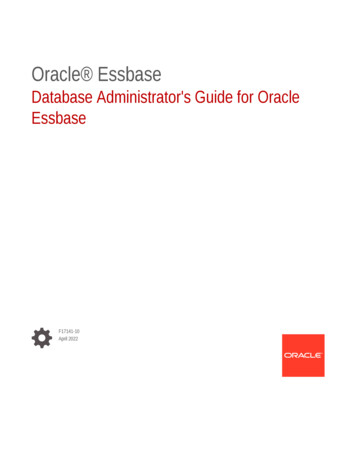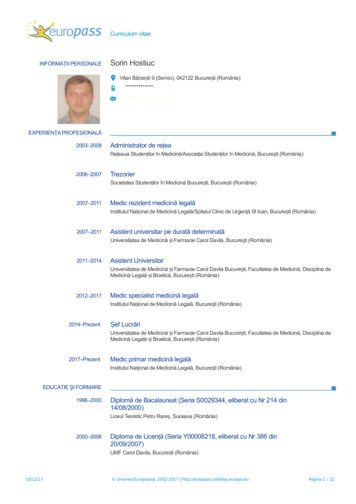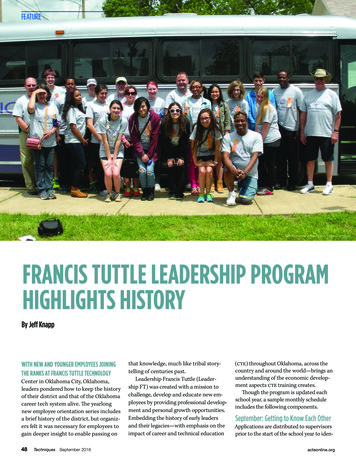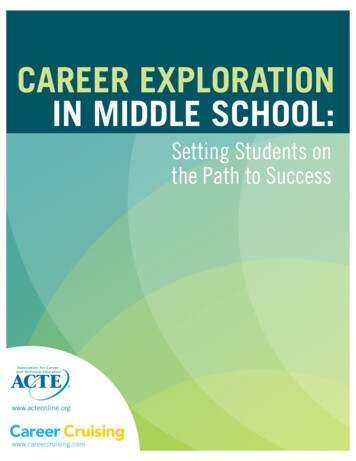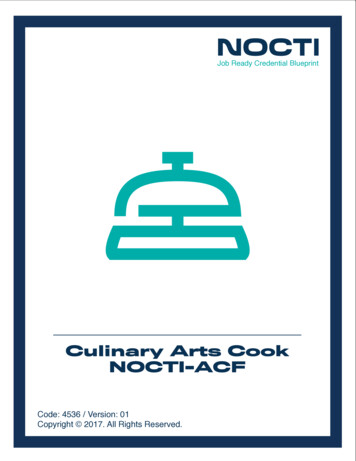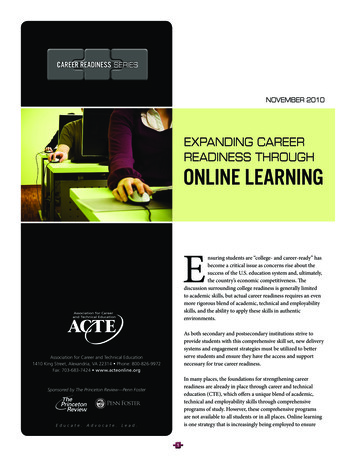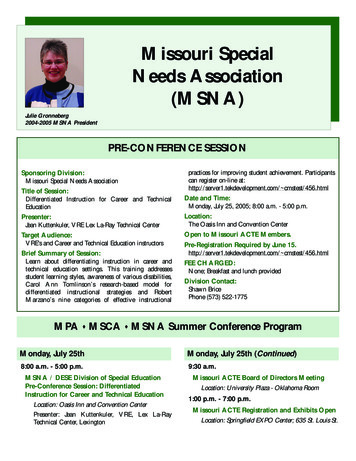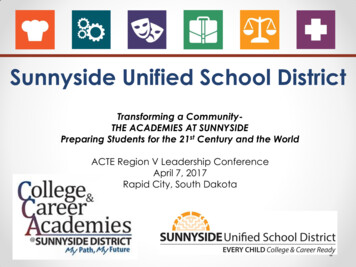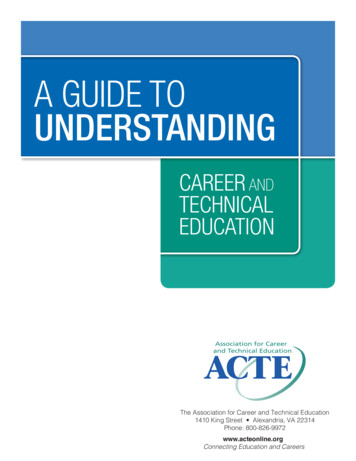
Transcription
A GUIDE TOUNDERSTANDINGCAREER ANDTECHNICALEDUCATIONThe Association for Career and Technical Education1410 King Street Alexandria, VA 22314Phone: 800-826-9972www.acteonline.orgConnecting Education and Careers
What is Career and Technical Education?HighFulfills employer needs that are90%80%70%60%50%40%30%20%10%94Percentage of highschool studentswho are part ofCTE, plus millionsof postsecondarystudents.Hospitality& TourismIntegrates withacademics in a rigorousand relevant curriculum.Marketing,Sales &ServiceFeatures high schooland postsecondarypartnerships,enabling clearpathwaysto certificationsand degrees.ManufacturingIncludes high schools, career centers,community and technical colleges,four-year universities and more.Agriculture,Food & NaturalResourcesCareerClusters Government& PublicAdministrationPrepares students to be collegeand career-ready by providingcore academic skills,employability skills andtechnical, job-specific skills.Law, PublicSafety &SecurityScience,Technology,Engineering nt sstudents fora range ofcareer optionsthrough16 CareerClusters and79 pathways.HumanServicesTransportation,Distribution& LogisticsArchitecture& ConstructionArts, A/VTechnology &CommunicationsEducation& TrainingFinanceAssociation for Careerand Technical Education1410 King StreetAlexandria, VA 22314Toll-free: 800-826-9972www.acteonline.orgConnecting Education and CareersRevised May 2014
CTSO, MEA, ACTE, ABCDEFG—What Do They All Mean?With so many organizations, entities and groups, it is a daunting task learning who is who and what is what in the world ofcareer and technical education (CTE). While initially geared toward the business community, this reference is also useful fornew CTE instructors, news media professionals, policymakers and others who are tasked with understanding the CTE world.As a living document, the intent is to continually update this reference to keep it relevant.What Is CTE?STEM Is CTEThere are literally hundreds of definitions of CTE. TheAssociation for Career and Technical Education (ACTE) hastaken all these definitions and condensed them into quickfacts that will help define CTE.In the past several years, students have lacked interest inscience, technology, engineering and mathematics(STEM), yet the job opportunities are in high demand. CTE prepares both youths and adults for a wide rangeof careers and further educational opportunities.These careers may require varying levels ofeducation—including industry-recognizedcertifications, postsecondary certificates, and twoand four-year degrees.Almost 12 million students participated in secondaryand postsecondary CTE programs during the 2011-12school year, as reported by the Office of Career,Technical, and Adult Education.According to the National Center for EducationStatistics, almost all high school students earn creditin CTE, and more than half earn 3 credits.The average high school graduation rate for studentsconcentrating in CTE programs is substantially higherthan the average national freshman graduation rate.Aperson with a CTE-related associate degree orcredential will earn on average between 4,000 and 19,000 more a year than a person with a humanitiesassociate degree.CTE is at the forefront of preparingstudents to be college- and career-ready. CTE equipsstudents with: 1Core academic skills and the ability to apply thoseskills to concrete situations in order to function inthe workplace and in routine daily activities.Employability skills (such as critical thinking andresponsibility) that are essential in any careerarea.Job-specific technical skills related to a specificcareer pathway.The issue brief CTE’s Role in STEM addresses suchconcerns as the dearth of professionals, lack of basicscience and math skills, and demographics. CTE providesstudents with opportunities by offering programs thatstrengthen the STEM understanding and introduce careerpathways. Through programs of study at the secondarylevel, students can explore their options and then decideon a career pathway that best suits their STEM interest.CTE students can then take the knowledge and skills theyhave learned to postsecondary education and into a highskill, high-paying job opportunity.The CTE classroom is the best STEM laboratory availablebecause it provides real-world, hands-on learning, as wellas enhances student engagement and learning.Statistics 50 percent of all STEM jobs are open to workerswith less than a bachelor’s degree.30 percent of today’s STEM-intensive jobs are inblue-collar fields.CTE Is Science—61 percent of CTE students interested ina science career report that their CTE courses equip themwith skills for the workforce.CTE Is Technology—50 percent of STEM jobs are inmanufacturing, health care and construction, whileanother 12 percent of STEM jobs are in installation,maintenance and repair.CTE Is Engineering—18 percent job growth is projectedfor environmental engineering technicians by 2022.These jobs typically require an associate degree and paymore than 45,000 per year.
CTE Is Mathematics—45 percent of CTE studentsinterested in a math career report that their CTE courseshelp them attain higher math and/or science skills.CTE StructureHow CTE is delivered varies by state and even by district.Within CTE, occupations and career specialties are oftengrouped into Career Clusters . There are 16 at the nationallevel. Not all states use all the clusters and some haveadditional ones. The current national Career Clusters are: Agriculture, Food & Natural Resources Architecture & Construction Arts, Audio/Video Technology & Communications Business Management & Administration Education & Training Finance Government & Public Administration Health Science Hospitality & Tourism Human Services Information Technology Law, Public Safety, Corrections & Security Manufacturing Marketing Science, Technology, Engineering & Mathematics Transportation, Distribution & LogisticsFurther specialization is achieved through comprehensiveprograms of study, which align academic and technicalcontent in a coordinated, non-duplicative sequence ofsecondary and postsecondary courses, and lead to anindustry-recognized credential or certificate at the postsecondary level or an associate or baccalaureate degree.At the local level, CTE is delivered at the middle school,high school, adult and postsecondary levels. It may belocated in a: Comprehensive high school—school that has bothacademic and CTE courses; some comprehensive highschools are designed as CTE magnet schools. CTE center/technical school—a separate school or centerwithin a district or among districts where students arebussed for their CTE courses. Community/technical college—for postsecondaryinstruction. Four-year college/university—for postsecondaryinstruction and teacher preparation. Adult education/employment center—for training for theadult population to assist in entering the workplace orupgrading skills. Correctional facility—to provide skills/knowledge toinmates.2As an additional resource on how CTE is specificallystructured in each state, ACTE has created, and continuesto maintain, individual state profiles. These profiles aredesigned to provide clarity and context to the complexand diverse CTE systems that exist today. For moreinformation, visit www.acteonline.org/stateprofiles.CTE FundingCTE programs are funded primarily by state and localresources, as is the case with most education programs.At the federal level, the Perkins Act also provides fundingto states, local school districts and postsecondaryinstitutions for program improvement and innovation.Carl D. Perkins Career and Technical Education ActThe Perkins Act was most recently reauthorized in August2006. The purpose of Perkins is to provide individualswith the academic and technical skills needed to succeedin a knowledge- and skills-based economy. Perkinssupports CTE that prepares its students both forpostsecondary education and the careers of their choice.Federal resources help ensure that CTE programs areacademically rigorous and up-to-date with the needs ofbusiness and industry. The federal contribution to CTE,just over 1 billion annually, supports innovation andexpands access to quality programs. Federal fundsprovide the principal source for innovation and programimprovement, and they help to drive state supportthrough a “maintenance-of-effort” provision in thefederal law.Perkins Basic State Grant funds are provided to statesthat, in turn, allocate funds by formula to secondaryschool districts and postsecondary institutions. Stateshave control over the split of funds between secondaryand postsecondary levels. After this decision is made,states must distribute at least 85 percent of the BasicState Grant funds to local programs using either theneeds-based formula included in the law or an alternateformula that targets resources to disadvantaged schoolsand students.States may reserve up to 10 percent for leadershipactivities and five percent (or 250,000, whichever isgreater) for administrative activities.State and Local FundingState and local funding support the CTE infrastructureand pay teachers’ salaries and other operating expenses.
Workforce Innovation and Opportunity Act (WIOA)Congress passed the Workforce Investment Act (WIA)Workforce Innovation and Opportunity Act in 2014.Itreplaced the Workforce Investment Act (WIA) in an effortto better align and strengthen the country’s job-trainingsystem. The enactment of WIOA, which went into effect onJuly 1, 2015, provides new opportunities for the workforcesystem and career and technical education to worktogether. Whether a state creates a “Combined Plan” thatincludes WIOA and the State Plan for Perkins, or a statewrites a “Unified Plan,” the state should consider howthese programs can best work together to prepareindividuals for careers that meet employer skill needs.WIOA requires states and local areas to develop careerpathways – a combination of education, training, careercounseling, and support services that align with the skillneeds of industries, through partnerships with secondaryand postsecondary CTE. By working together, local boardsand CTE can provide complementary services; for example,WIOA can help provide wrap-around support services forlow-income postsecondary CTE students. Local workforceboards must engage employers to ensure that workforceinvestment activities meet the needs of businesses and tofacilitate effective employer utilization of the localworkforce development system. WIOA emphasizes thecreation and use of industry-led sector partnerships toserve these and other purposes. CTE also engagesemployers in order to ensure that CTE programs preparestudents with skills demanded by employers. Workforceboards and CTE leaders can work together, includingthrough the use of sector partnerships, to preventduplication and efficiently engage employers in a systemicfashion.Key Terms21st Century Skills/Employability Skills/Soft Skills—Skills,other than technical knowledge, needed to succeed in theworkplace. Some examples include critical thinking,teamwork, problem solving and goal setting.Academic Integration—The blending of academic and CTEcurriculum. An example would be the Math-in-CTE programfrom the National Research Center for Career and TechnicalEducation.Apprenticeship—A system of training whereby workerslearn their skilled trade on the job in a structured andsupervised environment. The U.S. Department of Laboradministers the Registered Apprenticeship Program, which3aims to connect job seekers with employers. Regionaloffices support this activity.Articulation Agreement—A formal link between at leasttwo educational entities (i.e., high school and communitycollege) designed to make a smooth student transitionbetween entities.Career Clusters —A framework for organizingcurriculum around broad career categories, or CareerClusters, and more specific career pathways. There are 16identified national Career Clusters.Career Academies—Small learning communities that arefocused on a career theme and integrate rigorousacademics.Career Pathway—As described in a joint letter from theU.S. Departments of Education, Labor, and Health andHuman Services, career pathways are "connectededucation and training strategies and support servicesthat enable individuals to secure industry relevantcertification and obtain employment within anoccupational area and to advance to higher levels offuture education and employment in that area."Certification—Certifications indicate mastery of orcompetency in specific knowledge, skills or processesthat can be measured against a set of acceptedstandards. They are not tied to a specific educationalprogram, but are typically awarded through assessmentand validation of skills in cooperation with a business,trade association or other industry group.CTE Concentrator—As defined by OCTAE, a secondaryCTE concentrator is a secondary student who has earnedthree or more credits in a single CTE program area, ortwo credits in a single CTE program area for thoseprogram areas where two credit sequences at thesecondary level are recognized by the state and/or itslocal eligible recipients.A postsecondary CTE concentrator is apostsecondary/adult student who completes at least 12credits within a single program area sequence, or fewerthan 12 credits for those programs that terminate in anindustry-recognized credential, a certificate or a degreein less than 12 credits.Dual Credit—A program or class where participants earncredit in more than one area. For example, a culinaryclass that counts as a math class or a high school classthat is eligible for college credit.
Externship—A program where teachers/instructors spendtime in the business environment. This helpsteachers/instructors understand the workforce needs ofthe business community and what changes need to occur inthe classroom to reflect these needs.Industry Advisory Council (IAC)—It is required by thePerkins Act that CTE programs have IACs that meet at leastonce a year. Ideally, IACs help ensure that the CTEcurriculum is up-to-date and that what is being taught inthe classroom adequately prepares students for theworkplace.Industry-recognized Credentials—An industry-recognizedcredential is sought or accepted by employers within theindustry or sector involved as a recognized, preferred orrequired credential for recruitment, screening, hiring,retention or advancement purposes. Where appropriate,the credential is endorsed by a nationally recognized tradeassociation or organization representing a significant partof the industry or sector.Internship—An opportunity that allows students to receivehands-on knowledge and training while working for abusiness.Programs of Study (POS)—Federally defined in the PerkinsAct of 2006 as programs that: Incorporate secondary education andpostsecondary education elements.Include coherent and rigorous content alignedwith challenging academic standards and relevantcareer and technical content in a coordinated,non-duplicative progression of courses that alignsecondary education with postsecondaryeducation to adequately prepare students tosucceed in postsecondary education.May include the opportunity for secondary education students to participate in dual or concurrentenrollment programs or other ways to acquirepostsecondary education credits.Lead to an industry-recognized credential orcertificate at the postsecondary level, or anassociate or baccalaureate degree.Workforce Investment Board (WIB)—WIBs are regionalentities that were created to implement WIA. The WIB’smain role is to direct federal, state and local funding toworkforce development programs. WIBs oversee theOne-Stop career centers, where job seekers can getemployment information; find out about careerdevelopment training opportunities; and connect tovarious programs in their area. Services vary by state andWIB.Affiliated OrganizationsThroughout this document, you will learn about manyassociations dedicated to the students and educatorsinvolved in CTE. There are, however, a number of otherorganizations, companies and entities that are within theCTE community but don’t fall into those categories.Government Agencies1Bureau of Labor Statistics —The government entityunder the U.S. Department of Labor that is responsiblefor measuring labor market activity.2Employment and Training Administration (ETA) —Theagency within the U.S. Department of Labor thatadministers federal government job training and workerdislocation programs, federal grants to states for publicemployment service programs and unemploymentinsurance benefits. These services are primarily providedthrough state and local workforce development systems.Office of Career, Technical, and Adult Education3(OCTAE) —OCTAE administers and coordinates programsthat are related to adult education and literacy, CTE andcommunity colleges. OCTAE’s CTE initiatives are designedto administer state formula and discretionary grantprograms under the Perkins Act; provide assistance tostates to improve program quality, implementation andaccountability; and establish national initiatives that helpstates implement rigorous CTE programs.National Center for Innovation in Career and Technical4Education (NCICTE) —NCICTE performs scientificallybased research and evaluation to expand theunderstanding, increase the effectiveness and improvethe delivery of CTE. It is funded by OCTAE.State Director—The person(s) at the state level who isresponsible for secondary, postsecondary and adult CTE.Work-based Learning—Programs and opportunities thatallow students to see and understand how classroominstruction connects to the world of work.4Industry GroupsNational Automotive Technicians Education Foundation5(NATEF) —NATEF was founded to evaluate technician
training programs against standards developed by theautomotive industry, as well as recommend qualifyingprograms for NATEF accreditation.National Center for Construction Education and Research6(NCCER) —NCCER was “created to develop industry-drivenstandardized craft-training programs with portablecredentials and help address the critical workforce shortagefacing the construction industry.”10 key practices for changing what is expected ofstudents, what they are taught and how they are taught.OtherNational Technical Honor Society (NTHS)13—NTHS is achapter-based organization focused on honoring studentachievement and leadership, promoting educationalexcellence, awarding scholarships and enhancing careeropportunities for its membership.7National Council for Agricultural Education —The councilprovides leadership and coordination to shape the future ofschool-based agricultural education. Its board of directorsis made up of representatives from organizations andassociations focused on agriculture education and CTE.Curriculum/Testing Providers8ACT —ACT is an independent, not-for-profit organizationthat provides a broad array of assessment, research,information and program management solutions in theareas of education and workforce development.9MBA Research & Curriculum Center (MBAResearch) —MBAResearch is organized as a consortium of 37 stateeducation departments and other organizations to supporteducators in the preparation of students for careers inbusiness and marketing. It develops programs, strategiesand curricula.Career andTechnical StudentOrganizations (CTSO)More than 2 million students belong to and participate inCTSOs, according to a 2015 Achieve-NASDCTEcpublication, which are designed to provide leadershipdevelopment, motivation and recognition for students.The U.S. Department of Education recognizes thefollowing CTSOs and similar organizations:1410NOCTI —NOCTI is a provider of occupational competencyassessment products and services to secondary andpostsecondary educational institutions in the United Statesand around the world. A non-profit corporation, NOCTI isgoverned by a consortium of states consisting ofrepresentatives from each state and U.S. territory.11Project Lead The Way (PLTW) —PLTW provides rigorousand innovative STEM education curricular programs used inmiddle and high schools. More specifically, PLTW hasprograms and curriculum in engineering and biomedicalsciences.12Southern Regional Education Board (SREB) —SREB is anon-profit, non-partisan organization that works with 16member states to improve public preK–12 and highereducation. Founded by the region’s governors andlegislators in 1948, SREB was America’s first interstatecompact for education.In 1987, SREB established High Schools That Work (HSTW).HSTW uses research-proven strategies to help statestransform their public high schools into places where allstudents learn at high levels. Member schools implement5Business Professionals of America (BPA) —BPA has ahistory as a student organization that contributes to thepreparation of a world-class workforce through theadvancement of leadership and citizenship, as well asacademic and technological skills for students at thesecondary and postsecondary levels. Through cocurricular programs and services, members of BPAcompete in demonstrations of their business technologyskills, develop their professional and leadership skills,network with one another and professionals across thenation, and get involved in the betterment of theircommunity through good-works projects.15DECA —DECA, a national association of marketing,finance, hospitality and management education students,provides teachers and members with educational andleadership development activities to merge with theeducation classroom instructional program.Family, Career and Community Leaders of America16(FCCLA) —FCCLA makes a difference in families, careersand communities by addressing important personal, workand societal issues through family and consumer scienceseducation. Involvement in FCCLA offers members theopportunity to expand their leadership potential and
develop skills for life—planning, goal setting, problemsolving, decision making and interpersonalcommunication—that are necessary in the home andworkplace.Future Business Leaders of America—Phi Beta Lambda17(FBLA-BPL) —FBLA-PBL is a dynamic organization of youngpeople preparing for success as leaders in the country’sbusinesses, government and communities.18Future Educators Association (FEA)/Educators Rising —FEA is an organization that provides students interested ineducation-related careers with activities and materials thathelp them explore the teaching profession. FEA helpsstudents develop the skills and strong leadership traits thatare found in high-quality educators, it and significantlycontributes to the development of the next generation ofgreat educators.19HOSA-Future Health Professionals —HOSA’s two-foldmission is to promote career opportunities in the healthcare industry and to enhance the delivery of quality healthcare to all people.20National FFA Organization —FFA makes a positivedifference in the lives of students by developing theirpotential for premier leadership, personal growth andcareer success through agricultural education.National Postsecondary Agricultural Student Organization21(PAS) —PAS is an organization associated withagriculture/agribusiness and natural resources in approvedpostsecondary institutions offering baccalaureate degrees,associate degrees, diplomas and/or certificates.National Young Farmer Educational Association22(NYFEA) —NYFEA is the official adult student organizationfor agricultural education with the goal of being America’sassociation for educating agricultural leaders. Theassociation features leadership training, agricultural careereducation and community service opportunities.23SkillsUSA —SkillsUSA is a national organization servinghigh school and college students and professional memberswho are enrolled in technical, skilled and serviceoccupations, including health occupations.24Technology Student Association (TSA) —TSA is the onlystudent organization devoted exclusively to the needs ofstudents interested in STEM who are presently enrolled in,or have completed, technology education courses.National Coordinating Council for Career and Technical25Student Organizations (NCC-CTSO) —NCC-CTSO is a6council comprised of representatives from each CTSO,ACTE, the U.S. Department of Education and the NationalAssociation of State Directors of Career TechnicalEducation Consortium (NASDCTEc).ProfessionalAssociationsfor CTE InstructorsThere are numerous opportunities for career andtechnical educators to participate in a professionalassociation. In addition to union organizations like theNational Education Association and the AmericanFederation of Teachers, there are additional professionalassociations for every trade or area taught within CTE.Here is a list, although not comprehensive, of many ofthose associations.American Association for Agricultural Education26(AAAE) —AAAE is dedicated to studying, applying andpromoting the teaching and learning processes inagriculture. It is an individual membership organization.American Association of Family and Consumer Sciences27(AAFCS) —AAFCS is a professional individualmembership association for individuals with abaccalaureate degree or higher, professional-levelcertification or professional-level licensure in family andconsumer sciences.Association for Career and Technical Education28(ACTE) —ACTE is an individual membership organizationdedicated to the advancement of education thatprepares youth and adults for successful careers. ACTE iscommitted to enhancing the job performance and satisfaction of its members; to increasing public awarenessand appreciation for CTE programs; and to ensuringgrowth in local, state and federal funding for theseprograms by communicating and working with legislatorsand government leaders. ACTE is supported by a networkof state-affiliated associations.Association for Career and Technical Education Research29(ACTER) —ACTER is the premier professionalorganization for researchers, faculty, graduate students,administrators, policymakers and all others with globalinterests in workforce education research, education,issues and policy. It is an individual membershiporganization.
30Association for Skilled and Technical Sciences (ASTS) —ASTS is an individual membership organization for allinstructors, administrators, teacher educators, industryrepresentatives and others interested in the skilled trades.It was created when the National Association for Trade andIndustry Educators (NATIE) and the National Association ofState Supervisors for Trade and Industrial Education(NASSTIE) merged in 2006.31Career and Technical Education Equity Council (CTEEC) —The purposes of CTEEC are to promote and support CTE, tosupport equitable and full participation of all students andemployees in technical education, to encourageprofessional growth and development of its members, andto support the goals/objectives of the AdministrationDivision of ACTE. It is an individual membershiporganization that requires ACTE membership.32Epsilon Pi Tau —As an academic and professional honorsgroup for technology programs in higher education,workforce development programs and professionals inpractice, Epsilon Pi Tau provides honor and distinction tomembers, institutions, programs and individualsthroughout the world.International Vocational Education and Training33Association (IVETA) —IVETA is an organization andnetwork of vocational educators, vocational skills trainingorganizations, business and industrial firms, and otherindividuals and groups interested or involved in vocationaleducation and training worldwide. IVETA is dedicated tothe advancement and improvement of high-qualityvocational education and training wherever it exists and isneeded. It is an individual membership organization.34Marketing Education Association (MEA) —MEA exists tofoster the growth and development of marketingeducation, encourage and support the professionaldevelopment of marketing educators, encourageunderstanding of and support for marketing education, andmaintain an efficient and effective association. It is anindividual membership association.National Association of State Administrators of Family37and Consumer Sciences (NASAFACS) —The vision ofNASAFACS is to empower individuals and families tomanage the challenges of living and working in a diverseglobal society. Its unique focus is on family, work andtheir interrelationship. It is an individual membershiporganization that is an affiliate of ACTE.National Association of State Directors of Career38Technical Education Consortium (NASDCTEc) —NASDCTEc represents the state and territory heads ofsecondary, postsecondary and adult CTE across thenation. NASDCTEc, through leadership, advocacy andpartnerships, aims to support an innovative CTE systemthat prepares individuals to succeed in education andtheir careers, and poises the United States to flourish in aglobal, dynamic economy. In cooperation with theNational Career Technical Foundation (NCTEF), NASDCTEcprovides leadership and support for the National CareerClusters Framework.National Association of Supervisors of Agricultural39Education (NASAE) —NASAE is a professional organization established to provide members with informationessential for planning and conducting quality agriculturaleducation programs. It is an individual membershiporganization.National Association of Supervisors of Business40Education (NASBE) —NASBE is an organization ofbusiness education supervisors who are direct employeesof a state, region or local education agency, and has as itspurpose furthering the cause of business education andthe welfare of the field and professional members. It is anindividual membership organization.National Association of Teachers Educators for Family41and Consumer Sciences (NATEFACS) —NATEFACS is anational organization of teacher educators whosepurpose is to improve and strengthen teacher educationin family
grouped into Career Clusters . There are 16 at the national level. Not all states use all the clusters and some have additional ones. The current national Career Clusters are: Agriculture, Food & Natural Resources Architecture & Construction Arts, Audio/Video Technology & Communications usiness Management & Administration


